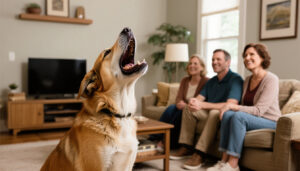
Did you know that 75% of dogs get itchy paws at some point1? This issue can be really tough for pet owners. They see their dogs licking, chewing, and scratching their paws a lot. It’s important to find out why and how to help your dog feel better.
Many things can make a dog’s paws itchy, like allergies, yeast infections, and environmental dangers. Finding out what’s causing it is key to making your dog’s paws healthy again123.
Key Takeaways
- Allergies, yeast infections, and environmental factors are common causes of itchy paws in dogs.
- Symptoms of itchy paws include excessive licking, redness, inflammation, and paw odor.
- Home remedies like paw balms and allergy-reducing shampoos can provide relief.
- Consulting a veterinarian is recommended for persistent or severe cases of itchy paws.
- Regular grooming and paw maintenance are essential for preventing and managing itchy paws.
- Recognizing the Signs of Itchy Paws
- Allergies: The Primary Culprit
- Yeast Infections and Bacterial Overgrowth
- Dry and Cracked Paw Pads
- ITCHY PAWS and Outdoor Hazards
- At-Home Remedies for Itchy Paws
- Veterinary Treatments for Persistent Itchy Paws
- Grooming and Hygiene for Paw Health
- Environmental Modifications and Management
- Diet and Nutritional Support
- Conclusion
- FAQ
- Source Links
Recognizing the Signs of Itchy Paws
Spotting the signs of itchy paws in dogs is key to solving the problem. Dogs often lick and chew their paws because they’re trying to ease the itch4. Look for signs like redness, discoloration, and a bad smell on their paws4. If it gets worse, they might limp or have hot spots4.
Keep an eye on how your dog’s paws look and act. This can help you figure out what’s making them uncomfortable4. Knowing the signs is important for quick and effective help4.
Common Symptoms
- Excessive paw licking or chewing
- Red and irritated paws
- Paw discoloration
- Abnormal paw odor
- Limping
- Hot spots
“Paying close attention to your dog’s paws and any changes in behavior can help you identify the underlying issue.”4
Allergies: The Primary Culprit
Allergies are the top reason why dogs get itchy paws. Dogs can have many allergies, like environmental, food, and flea allergies. These can make their paws red, itchy, and irritated5.
Skin allergies in dogs, or allergic dermatitis, are very common5. They can come from fleas, certain foods, or things in the environment5.
Signs of an allergy can be ear infections, skin irritation, and sneezing6. Dogs with seasonal allergies often get ear infections because of histamine affecting their ear skin6. It’s important to see a vet to figure out and treat your dog’s allergy.
Food allergies in dogs are less common than environmental or flea allergies,5 but they can still cause big reactions7. These allergies usually happen to proteins in food, like beef, chicken, lamb, eggs, dairy, and soy7.
Finding out what’s causing your dog’s allergies can be hard7. Testing often involves trying different foods to see what causes a reaction7. Vets might suggest treatments like antihistamines, cortisones, special shampoos, Omega-3 supplements, or anti-inflammatory wipes5.
Working with your vet can help your dog feel better from itchy paws due to allergies6. Call Dupont Veterinary Clinic at 260-637-7676 for advice on over-the-counter allergy meds, like Benadryl or Zyrtec6.
Yeast Infections and Bacterial Overgrowth
Yeast infections and bacterial overgrowth can make a dog’s paws itchy. These conditions lead to irritation and inflammation. They also cause a musty or cheese-like smell8. Some dog breeds like West Highland White Terrier and Cocker Spaniel often get yeast infections8.
Dogs with certain ear types, like Golden Retrievers and Bichon Frise, are also at risk8. Dogs with allergies are more likely to get yeast infections8.
Telltale Signs and Prevention
A dog with a yeast infection on its paws may lick too much, have redness, discharge, and hair loss8. Keeping your dog’s paws clean and dry helps prevent these infections89. Yeast infections are more common in the summer because it’s warm and humid9.
Regular baths with antifungal shampoos and checking skin folds for bacteria are key to prevention9.
If your dog has a musty smell, scratches a lot, or shows skin changes, see a vet89. Treatment might include creams, wipes, or shampoos, or oral medication for severe cases9. Treating yeast infections quickly can make your dog more comfortable and keep its paws healthy.
“Maintaining a clean and dry environment for your dog’s paws is crucial in preventing yeast infections and bacterial overgrowth.”
Dry and Cracked Paw Pads
A dog’s paw pads can get dry and cracked, causing discomfort and irritation10. This can lead to dogs licking their paws a lot10. Taking good care of your dog’s paw pads is important10. Things like hot pavement, cold weather, chemicals, and allergies can cause dry, cracked paw pads10.
Dogs need their paw pads to cushion shocks, sweat, regulate temperature, and balance11. Dry, cracked paw pads are common11. Heat and cold can make it worse11. Walking on rough surfaces can also cause paw pads to crack11.
Allergies can make a dog’s paw pads crack, swell, and itch11. A disease called hyperkeratosis makes paw pads rough and thick11. Dermatitis can also cause dry, cracked paw pads, along with scabs and ulcers11. Not getting enough zinc can make a dog’s paw skin dry and thick11.
To prevent and treat dry, cracked paw pads, use creams made for dogs and apply paw balm before and after walks11. Avoid walks in extreme temperatures11. If your dog has allergies, hyperkeratosis, dermatitis, or lacks nutrients, see a vet11.
| Ingredient | Benefits |
|---|---|
| Shea Butter | Moisturizes paws and aids in healing and cell regeneration12 |
| Beeswax | Forms a protective layer over cracks or cuts and has anti-inflammatory properties12 |
| Virgin Coconut Oil | Improves hotspots and reduces skin irritation12 |
| Argan Oil | Contains antioxidants that fight free radicals and promotes healing and cell regeneration12 |
| Hempseed Oil | Rich in Omega 3 and Omega 6 fatty acids, promoting skin elasticity and health12 |
| Candelilla Wax | Provides a barrier for skin hydration as a vegan alternative to beeswax12 |
Neosporin is safe for pets but not for areas dogs might lick, like paws10. Organic paw balms with shea butter, beeswax, and coconut oil can moisturize dry paw pads10. Watch for signs like bleeding, infection, or limping to know if your dog’s paw needs help12.
For mild cases, clean away irritants and use paw wax balm12. But for serious issues like allergies or nutrient problems, a vet’s help is needed11.
ITCHY PAWS and Outdoor Hazards
Outdoor activities can expose dogs to irritants that make their paws itchy. Grass, plants, or objects like foxtails and grass awns can cause paw irritation and swelling13. These can even move deeper into the body if not treated. Contact allergies can make a dog’s paws itch, and pollen allergies can cause itchiness after contact13.
Grass Allergies and Foreign Objects
Grass allergies are a big reason for itchy paws in dogs14. Dogs and cats can get environmental allergies from pollen in spring and fall, or mold in the fall14. Sharp objects like foxtails and grass awns can stick in a dog’s paw, causing irritation and infection if not removed13. Checking your dog’s paws after being outside and using paw-protective boots can prevent these problems.
Knowing when your dog’s paws are irritated is key to fixing the issue fast15. Signs include excessive licking, chewing, or limping15. Pododermatitis, caused by outdoor hazards, can show as redness, swelling, or hair loss15. Finding and treating the cause, like an allergy or foreign object, is crucial for relief and prevention.
| Outdoor Hazard | Potential Symptoms | Prevention Tips |
|---|---|---|
| Grass Allergies | Itchy, irritated paws, excessive licking, chewing | Use paw-protective boots, wipe paws after outdoor activities |
| Foxtails and Grass Awns | Paw irritation, inflammation, infection | Thoroughly inspect paws after being outdoors, remove any foreign objects |
Understanding outdoor hazards and taking steps to prevent them can help dogs stay comfortable and healthy.
At-Home Remedies for Itchy Paws
Dealing with a dog’s itchy paws can be tough, but there are many at-home remedies that work well. Pet owners can choose from over-the-counter and natural treatments to ease their furry friend’s discomfort.
Natural and Over-the-Counter Solutions
Benadryl (diphenhydramine) is often used for itchy paws because it reduces inflammation and eases itching16. But, always talk to your vet before giving it to your dog to make sure it’s safe and the right amount.
Diluted apple cider vinegar is another natural choice. Mixing it with water can soothe mild skin infections and stop the itch17. Use a 50% apple cider vinegar and 50% water mix on the itchy spots.
For dry, cracked paw pads, moisturizing shampoos and paw balms are great. They help fix the skin’s barrier and stop more irritation16.
Omega fatty acid supplements, like fish oil, can also help. They make a dog’s coat healthier and lessen inflammation17. Adding these supplements to your dog’s diet can help with itchy paws and overall skin health.
| Remedy | Benefits |
|---|---|
| Benadryl (diphenhydramine) | Reduces inflammation and provides itch relief |
| Diluted apple cider vinegar | Soothes mild yeast infections and alleviates itching |
| Moisturizing shampoos and paw balms | Restore the skin’s natural barrier and prevent further irritation |
| Omega fatty acid supplements | Improve coat health and reduce inflammation |
Using these natural and over-the-counter remedies, dog owners can help their pets feel better. They also support their skin health161718.
Veterinary Treatments for Persistent Itchy Paws
If home remedies don’t help your dog’s itchy paws, see a vet19. Vets can find out why your dog is itchy, like allergies or infections20. Dogs with itchy skin often go to the vet for help20.
For itchy paws, vets might suggest creams, pills, or shots19. Pills can ease itchiness from allergies1920. Some dogs, like Cocker Spaniels and French Poodles, get skin problems often and need special care20.
Fixing skin issues in dogs can be hard, needing tests and treatments20. Bad cases might make the paws smell or lose hair from too much scratching19. If you think your pet is sick, seeing a vet is key for the right diagnosis and treatment plan19.
| Veterinary Treatment | Description |
|---|---|
| Topical Solutions | Medicated creams, ointments, or sprays applied directly to the affected paw areas to soothe and treat the underlying condition. |
| Antihistamines | Oral medications that can help manage the symptoms of environmental allergies that may be causing the itchy paws. |
| Immunotherapy | A long-term treatment approach involving gradual exposure to the specific allergens triggering the dog’s itchy paws, helping to desensitize the immune system and provide lasting relief. |
Vets might suggest a special plan for dogs with itchy paws19. Sometimes, you’ll need to keep treating the itchiness for life20.
Grooming and Hygiene for Paw Health
Keeping your dog’s paw hygiene in check is key to avoiding itchy paws. Regular paw inspection and paw trimming cuts down on yeast infections and irritation21. Also, cleaning their paws after they go outside removes allergens and irritants, keeping them comfy and healthy22.
Regular Maintenance and Inspection
Adding paw care to your dog’s grooming routine is a must for their health22. Check for cuts, scrapes, or foreign objects in their paws. Look for dryness, cracking, or signs of discomfort23. Trimming hair around their paw pads helps prevent dirt and debris from sticking, making post-outdoor cleaning easier22.
Getting your dog used to paw handling early on is a good idea22. Use treats and praise during and after paw grooming to make it a positive experience for both of you22.
| Paw Hygiene Practices | Benefits |
|---|---|
| Regular paw inspection and trimming | Reduces risk of infections, irritation, and other paw-related issues |
| Thorough cleaning after outdoor activities | Removes potential allergens and irritants, keeping paws healthy |
| Early acclimatization to paw handling | Eases the paw grooming process and creates positive associations |
“Consistent paw cleaning should be incorporated into routine grooming to effectively maintain a dog’s paw health.”22
Environmental Modifications and Management
Changing your dog’s environment can help with itchy paws. By reducing allergens like pollen, mold, and dust mites, you can lessen skin irritation24. Clean your home often, use air purifiers, and avoid harsh chemicals to make a safe space for your pet25. Also, manage where your dog goes, like avoiding high-pollen areas, to cut down on allergens26.
Using natural remedies can also help your dog’s skin26. Oatmeal baths, apple cider vinegar rinses, and coconut oil can soothe and protect their skin25. Supplements with omega-3 and omega-6 fatty acids, vitamins, and probiotics can also boost their skin and coat health26.
Regular grooming and vet visits are key to fighting itchy paws26. Proper grooming, like regular baths and paw checks, can reduce allergens on their coat and skin25. Working with your vet can help diagnose and treat any skin issues24.
| Environmental Factor | Impact on Dog Skin | Management Strategies |
|---|---|---|
| Pollen | Increased itching, inflammation, and skin irritation | Limit outdoor time during peak pollen seasons, use air purifiers, bathe frequently |
| Dust Mites | Triggers allergic reactions and worsens skin conditions | Use dust-mite-resistant bedding, vacuum regularly, and consider air purifiers |
| Household Chemicals | Can cause contact dermatitis and skin irritation | Opt for natural, hypoallergenic cleaning products and avoid harsh chemicals |
| Grass and Plants | Exposure can lead to skin irritation and allergic reactions | Limit time in grassy areas, inspect paws after outdoor activities, and use protective booties |
By making these changes, you can lower your dog’s exposure to allergens and make their living space more comfortable for their skin252426.
Diet and Nutritional Support
Your dog’s diet and nutrition play a big role in their skin and paw health. If food allergies cause itchy paws, changing their diet can help find and stop the problem ingredients27. Common food allergens for dogs include proteins from dairy, beef, chicken, chicken eggs, soy, or wheat gluten27.
Adding omega fatty acids and supplements to your dog’s diet can boost their skin health and lessen itchy paws28. Since 80% of a dog’s immune system is in their gut, gut health is key28. Raw diets with enzymes and probiotics can help remove allergens and boost the immune system28.
Addressing Food Allergies and Skin Health
27 Food allergies are common in dogs. The best way to find a food allergy is through an 8 to 12-week trial of a hypoallergenic diet27. There are three types of diets for treating food allergies, and vet-prescribed ones are stricter than store-bought ones27. Most food allergies can be managed with a hypoallergenic diet, but dogs might get other allergies later27.
28 Grains aren’t needed in a dog’s diet and can be cut out to lessen allergy triggers28. If novel proteins don’t help, see a vet for advice28.
| Nutrient | Benefits for Skin and Paw Health |
|---|---|
| Omega Fatty Acids | Reduce inflammation, improve skin barrier function, and support overall skin health. |
| Probiotics | Support a healthy gut microbiome, which can positively impact the immune system and skin. |
| Vitamin E | Antioxidant properties that help protect skin cells and promote healthy skin. |
| Zinc | Crucial for wound healing, skin cell growth, and maintaining skin integrity. |
“Proper nutrition is essential for maintaining healthy skin and paws in dogs. A balanced diet with the right nutrients can make a significant difference in managing skin-related issues.”
By tackling food allergies and adding the right nutrients to your dog’s diet, you can greatly improve their skin and paw health. This can reduce how often and how bad their itchy paws get2728.
Conclusion
Itchy paws in dogs can be a big problem, but you can help your dog feel better29. By knowing what causes itchy paws, like allergies and infections, you can fix the problem30.
Using products like Curicyn Original Formula can help reduce swelling and heal the skin29. Keeping your dog clean and checking for allergies can also stop it from happening again30.
If your dog’s itchy paws don’t get better, you should talk to a vet30. They can give your dog shots or other treatments to help30. By taking good care of your dog’s itchy paws, you can make sure they stay happy and healthy29.
FAQ
What are the common symptoms of itchy paws in dogs?
What are the most common causes of itchy paws in dogs?
How can I identify if my dog’s itchy paws are caused by allergies?
What are the signs of a yeast infection or bacterial overgrowth in a dog’s paws?
How can I help soothe my dog’s dry and cracked paw pads?
What can I do to prevent and manage outdoor hazards that may cause itchy paws?
What are some effective at-home remedies for itchy paws in dogs?
When should I consult a veterinarian for my dog’s itchy paws?
How can proper grooming and hygiene help manage itchy paws in dogs?
Source Links
- https://toegrips.com/dog-itchy-paws/
- https://www.metlifepetinsurance.com/blog/pet-health/stop-itchy-paws-in-their-tracks/
- https://www.vetniquelabs.com/blogs/vets-corner/itchy-paws-in-dogs-5-causes?srsltid=AfmBOoqj85YVhR2S3U6cw3geTEgw5P3S0N2Wbv-7wixKvcSsTCwQ7vZG
- https://www.akc.org/expert-advice/health/why-is-my-dog-so-itchy/
- https://www.akc.org/expert-advice/health/dog-allergies-symptoms-treatment/
- https://www.dupontvet.com/blog/allergies/
- https://vcahospitals.com/know-your-pet/allergy-general-in-dogs
- https://www.akc.org/expert-advice/health/yeast-infections-in-dogs-what-to-know/
- https://levanroadvet.com/blog/paws-yeast-infection/
- https://naturaldog.com/blogs/whole-dog-health/paw-soother-how-to-heal-your-dogs-dry-cracked-paw-pads?srsltid=AfmBOorOQSrmPtjasPxmVwaxMIex8W9SzKMJadW9C8U4uwPWYi165EBU
- https://www.dulacfarmaceutici.com/en/blog/dry-cracked-dog-paws/?srsltid=AfmBOooLTPAcS13f22OP7hASzscvQ21rXUqOS1q-9Y_hAfnGm7T6aLJo
- https://puppington.co/blogs/pup-wellness/what-causes-dry-cracked-dog-paws?srsltid=AfmBOoqq4J2aHs_gD6mG9I2iTs_QVzYych0MXeyp3rpMbxDrN_pu0Vx1
- https://heartandpaw.com/pet-parent-resources/itchy-dog-paws
- https://www.discovermagazine.com/planet-earth/pets-have-seasonal-allergies-too-like-itchy-paws-and-watery-eyes
- https://vcahospitals.com/know-your-pet/pododermatitis-in-dogs
- https://www.okvets.com/post/ remedies-for-itchy-pet-paws
- https://www.thesprucepets.com/home-remedies-for-itchy-dogs-4177184
- https://www.petmd.com/dog/general-health/home-remedies-for-dog-itchy-skin
- https://www.vetniquelabs.com/blogs/vets-corner/itchy-paws-in-dogs-5-causes?srsltid=AfmBOopZsrKtAikXKV_VS8t1VBaKRjE-CZgNgQMSSql39uwKHrCEcvF4
- https://vcahospitals.com/know-your-pet/pruritus-itching-and-scratching-in-dogs
- https://www.akc.org/expert-advice/health/clean-dog-paws/
- https://www.abkgrooming.com/blogs/tips-tricks/effective-ways-clean-dogs-paws?srsltid=AfmBOop6bG53glOFq_MeWdJfNJQsYS60rQHGY9xPhB0aoMQcwO5wmsCL
- https://rockykanaka.com/how-to-treat-my-dogs-itchy-paws/
- https://www.nalahealth.dog/za/environmental-allergy-in-dogs/
- https://bettervet.com/resources/pet-conditions/dermatitis-in-dogs
- https://www.pethonesty.com/blogs/blog/3-tips-to-relieve-dry-skin-on-dogs
- https://vcahospitals.com/know-your-pet/food-allergies-in-dogs
- https://blog.mudbay.com/dog-health-problems/how-to-help-dogs-with-allergies-food-intolerances-and-other-itchy-skin-issues/
- https://curicyn.com/blog/dogs-with-itchy-paws-can-oftentimes-be-treated-at-home/
- https://bettervet.com/resources/pet-symptoms/excessive-itching-in-dogs











